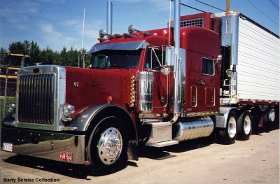Cascadia Shifting......
Topic 9756 | Page 1
It's just a matter of finding the sweet spot. On my Cascadia, for downshifting that sweet spot is about 1150 RPM; for upshifting it's about 1750.

Double clutching or floating? If using the cluth,remember to only use two inches of pedal.Depressing the pedal too far engauges the clutch brake...grind,grind, Grind,if you try to shift at the same time.
Double Clutch:
To engage and then disengage the clutch twice for every gear change.
When double clutching you will push in the clutch, take the gearshift out of gear, release the clutch, press the clutch in again, shift the gearshift into the next gear, then release the clutch.
This is done on standard transmissions which do not have synchronizers in them, like those found in almost all Class A trucks.
Double Clutching:
To engage and then disengage the clutch twice for every gear change.
When double clutching you will push in the clutch, take the gearshift out of gear, release the clutch, press the clutch in again, shift the gearshift into the next gear, then release the clutch.
This is done on standard transmissions which do not have synchronizers in them, like those found in almost all Class A trucks.

It's just a matter of finding the sweet spot. On my Cascadia, for downshifting that sweet spot is about 1150 RPM; for upshifting it's about 1750.
That's what I'm shooting for most times. Thanks!

Double clutching or floating? If using the cluth,remember to only use two inches of pedal.Depressing the pedal too far engauges the clutch brake...grind,grind, Grind,if you try to shift at the same time.
Double clutching seems to work the best floating works but some gears 5-6 6-7 will stick and I'll get stuck...I'm a rookie
Double Clutch:
To engage and then disengage the clutch twice for every gear change.
When double clutching you will push in the clutch, take the gearshift out of gear, release the clutch, press the clutch in again, shift the gearshift into the next gear, then release the clutch.
This is done on standard transmissions which do not have synchronizers in them, like those found in almost all Class A trucks.
Double Clutching:
To engage and then disengage the clutch twice for every gear change.
When double clutching you will push in the clutch, take the gearshift out of gear, release the clutch, press the clutch in again, shift the gearshift into the next gear, then release the clutch.
This is done on standard transmissions which do not have synchronizers in them, like those found in almost all Class A trucks.
As was mentioned, it's all about finding the sweet spot. You can take a dozen trucks, all the same with the same transmission and depending on the miles, how they were driven and adjustments, they will all have the sweet spot a little bit different. It won't be much from one to the next but definitely enough to annoy you from time to time. Don't forget too that the load will also add in the other variable as well. If my Pro Star is light, I may upshift at around 1400 but if she's loaded heavy, she likes around 1600 although my down shift points are the same and I barely have to bump the throttle. Different engines will also have a bit too say about your shift points too but at the end of the day, it's just a matter of you becoming one with the truck, when it happens, you'll know.

As was mentioned, it's all about finding the sweet spot. You can take a dozen trucks, all the same with the same transmission and depending on the miles, how they were driven and adjustments, they will all have the sweet spot a little bit different. It won't be much from one to the next but definitely enough to annoy you from time to time. Don't forget too that the load will also add in the other variable as well. If my Pro Star is light, I may upshift at around 1400 but if she's loaded heavy, she likes around 1600 although my down shift points are the same and I barely have to bump the throttle. Different engines will also have a bit too say about your shift points too but at the end of the day, it's just a matter of you becoming one with the truck, when it happens, you'll know.
That's really good advice. Guess I'll just keep trying to get the timing now and pay a little more attention to my rpms. I appreciate it!
New Reply:
New! Check out our help videos for a better understanding of our forum features

















Preview:








 TT On Facebook
TT On Facebook
I'm new. To this forum and to Trucking. I'm a 2 month vet. I know I know hold all the applause. Anywho. In school we used Prostars, after a week grinding went away got into rythym everything good. Now the company truck I was assigned is a Cascadia.....this truck.....once I think I have points figured out boom, whoever has their window down just got their ears grinded to a pulp. I know the theory of 2+5 (7) etc downshifting and things have become smoother but I need some pointers on what the hell I'm doing wrong...could it be my timing, or I'm acting like I'm too comfortable with it? Any ideas? Thanks!